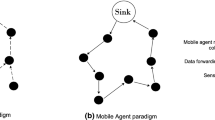Abstract
As software entities that migrate among nodes, mobile agents (MAs) are able to deliver and execute codes for flexible application re-tasking, local processing, and collaborative signal and information processing. In contrast to the conventional wireless sensor network operations based on the client–server computing model, recent research has shown the efficiency of agent-based data collection and aggregation in collaborative and ubiquitous environments. In this paper, we consider the problem of calculating multiple itineraries for MAs to visit source nodes in parallel. Our algorithm iteratively partitions a directional sector zone where the source nodes are included in an itinerary. The length of an itinerary is controlled by the angle of the directional sector zone in such a way that near-optimal routes for MAs can be obtained by selecting the angle efficiently in an adaptive fashion. Simulation results confirm the effectiveness of the proposed algorithm as well as its performance gain over alternative approaches.





Similar content being viewed by others
Notes
OPNET, http://www.opnet.com/.
References
Vasilakos, A., Parashar, M., Karnouskos, S., & Pedrycz, W. (2009). Autonomic communications. New York: Springer.
Vasilakos, A., & Pedrycz, W. (2006). Ambient intelligence, wireless networking, ubiquitous computing. Boston: Artech House, Press.
Pedrycz, W., & Vasilakos, A. (2000). Computational intelligence in telecommunications networks. Boca Raton: CRC Press.
Zhang, D., Wan, J., Liu, Q., Guan, X., & Liang, X. (2012). A taxonomy of agent technologies for ubiquitous computing environments. Transactions on Internet and Information Systems, 6(2), 547–565.
Zhang, D., Zhang, D., Xiong, H., Hsu, C., & Vasilakos, A. (2014). BASA: Building mobile Ad-Hoc social networks on top of android. IEEE Network, 28(1), 4–9.
Zhang, D., Guo, M., Zhou, J., Kang, D., & Cao, J. (2012). Asynchronous event detection for context inconsistency in pervasive computing. International Journal of Ad Hoc and Ubiquitous Computing, 11(4), 195–205.
Chen, M., Gonzalez, S., Zhang, Q., & Leung, V. C. M. (2010). Code-centric rfid system based on software agent intelligence. IEEE Intelligent Systems, 25(2), 12–19.
Chen, M., Gonzalez, S., Leung, V. C. M., Zhang, Q., & Li, M. (2010). A 2g-rfid based e-healthcare system. IEEE Wireless Communications, 17(1), 37–43.
Zhou, L., Geller, B., Zheng, B., Wei, A., & Cui, J. (2009). System scheduling for multi-description video streaming over wireless multi-hop networks. IEEE Transactions on Broadcasting, 55(4), 731–741.
Qi, H., & Wang, F. (2001). Optimal itinerary analysis for mobile agents in ad hoc wireless sensor networks. In Proceedings of the IEEE 2001 International Conference on Communications (ICC 2001). Helsinki, Finland.
Chen, M., Kwon, T., Yuan, Y., Choi, Y., & Leung, V. C. M. (2007). Mobile agent-based directed diffusion in wireless sensor networks. EURASIP Journal on Applied Signal Processing, 2007(1), 219–219.
Chen, M., Leung, V.C.M., Mao, S., Kwon, T., & Li, M. (2009). Energy-Efficient itinerary planning for mobile agents in wireless sensor networks. In Proceedings of the IEEE International Conference on Communications (ICC 2009) (pp. 1–5). Bresden, Germany.
Wu, Q., Rao, N. S. V., Barhen, J., Iyengar, S. S., Vaishnavi, V. K., Qi, H., et al. (2004). On computing mobile agent routes for data fusion in distributed sensor networks. IEEE Transactions on Knowledge and Data Engineering, 16, 740–753.
Konstantopoulos, C., Mpitziopoulos, A., Gavalas, D., & Pantziou, G. (2010). Effective determination of mobile agent itineraries for data aggregation on sensor networks. IEEE Transactions on Knowledge and Data Engineering, 22(12), 1679–1693.
Chen, M., Gonzalez, S., & Leung, V. C. M. (2007). Applications and design issues for mobile agents in wireless sensor networks. Wireless Communications, IEEE, 14(6), 20–26.
Chen, M., Gonzlez, S., Zhang, Y., & Leung, V. C. M. (2009). Multi-agent itinerary planning for sensor networks. In Proceedings of the IEEE 2009 International Conference on Heterogeneous Networking for Quality, Reliability, Security and Robustness (QShine 2009). Las Palmas de Gran Canaria, Spain.
Author information
Authors and Affiliations
Corresponding author
Rights and permissions
About this article
Cite this article
Wang, J., Zhang, Y., Cheng, Z. et al. EMIP: energy-efficient itinerary planning for multiple mobile agents in wireless sensor network. Telecommun Syst 62, 93–100 (2016). https://doi.org/10.1007/s11235-015-9985-9
Published:
Issue Date:
DOI: https://doi.org/10.1007/s11235-015-9985-9




